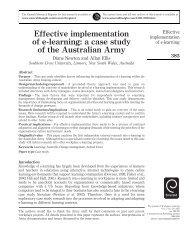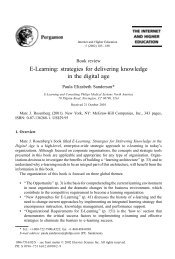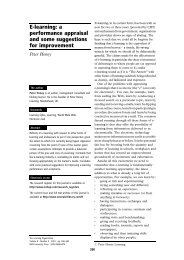Designing E-learning Interactions in the 21st Century: revisiting and ...
Designing E-learning Interactions in the 21st Century: revisiting and ...
Designing E-learning Interactions in the 21st Century: revisiting and ...
You also want an ePaper? Increase the reach of your titles
YUMPU automatically turns print PDFs into web optimized ePapers that Google loves.
Andrew Ravenscroft 141<br />
many contemporary approaches to e-<strong>learn<strong>in</strong>g</strong> that emphasise <strong>the</strong> necessity for<br />
collaborative, argumentative <strong>and</strong> reflective discourses. He conceived <strong>learn<strong>in</strong>g</strong> as<br />
an <strong>in</strong>structional process aimed at transform<strong>in</strong>g <strong>the</strong> m<strong>in</strong>d of <strong>the</strong> child <strong>in</strong>to that of an<br />
adult <strong>and</strong> treated <strong>the</strong> role of language as primary <strong>in</strong> this process, with <strong>the</strong> relevant<br />
activities performed primarily <strong>in</strong> school. However, it is accepted that his ideas are<br />
not limited to relationships <strong>in</strong>volv<strong>in</strong>g strictly schoolchildren <strong>and</strong> adult teachers,<br />
but more appropriately, to any relevant context <strong>in</strong>volv<strong>in</strong>g a learner <strong>and</strong> a more<br />
learned o<strong>the</strong>r. Similarly, his <strong>the</strong>ories are not bound to <strong>the</strong> `traditional' concept of a<br />
school. Never<strong>the</strong>less, I will reta<strong>in</strong> his orig<strong>in</strong>al taxonomy to reta<strong>in</strong> au<strong>the</strong>nticity for<br />
<strong>the</strong> purpose of this article.<br />
Vygotsky draws a clear dist<strong>in</strong>ction between lower level mental processes, such<br />
as elementary perception <strong>and</strong> attention, <strong>and</strong> higher level mental processes that<br />
<strong>in</strong>clude verbal thought, logical memory, selective attention <strong>and</strong> reason<strong>in</strong>g. He<br />
argues for a qualitative dist<strong>in</strong>ction between <strong>the</strong>se two levels of mental<br />
performance, because unlike lower level activity, <strong>the</strong> higher level is: mediated<br />
through cultural symbols <strong>and</strong> tools; self-regulated ra<strong>the</strong>r than bound to a stimulus<br />
context; social <strong>in</strong> orig<strong>in</strong>; <strong>and</strong>, <strong>the</strong> result of conscious awareness ra<strong>the</strong>r than an<br />
automatic response.<br />
Critical <strong>in</strong> dist<strong>in</strong>guish<strong>in</strong>g higher <strong>and</strong> lower level activity is <strong>the</strong> qualitative<br />
developmental transition that occurs when language, or any o<strong>the</strong>r sign system, is<br />
<strong>in</strong>ternalised to operate as a mediat<strong>in</strong>g factor between environmental stimuli <strong>and</strong> an<br />
<strong>in</strong>dividual's response. This mediation transforms <strong>the</strong> lower level activity by lift<strong>in</strong>g it<br />
onto a higher plane <strong>and</strong> can be achieved through <strong>the</strong> application of material or<br />
psychological tools. Fur<strong>the</strong>r, <strong>in</strong> us<strong>in</strong>g such tools we become conscious <strong>and</strong> <strong>in</strong><br />
control of our mental activities. However, Vygotsky considered language to be <strong>the</strong><br />
most <strong>in</strong>terest<strong>in</strong>g <strong>and</strong> powerful of <strong>the</strong>se semiotic mediators <strong>and</strong> <strong>the</strong> primary tool for<br />
th<strong>in</strong>k<strong>in</strong>g. He claims that <strong>the</strong>se higher mental functions orig<strong>in</strong>ate <strong>in</strong> <strong>the</strong> social, <strong>and</strong><br />
development proceeds `from action to thought' <strong>and</strong> <strong>the</strong>refore communication <strong>and</strong><br />
social contact are essential. It is through <strong>the</strong> communicative process that external<br />
sign systems convey<strong>in</strong>g <strong>in</strong>terpersonal communication become <strong>in</strong>ternalised to<br />
operate as <strong>in</strong>trapersonal psychological tools that can transform mental function<strong>in</strong>g.<br />
In o<strong>the</strong>r words, <strong>in</strong>ternal language <strong>and</strong> thought are transformed from <strong>the</strong> `outside'.<br />
This idea is critical to Vygotsky's notions about conceptual development <strong>and</strong> <strong>the</strong><br />
evolution of l<strong>in</strong>guistic mean<strong>in</strong>g as <strong>the</strong> m<strong>in</strong>d of <strong>the</strong> child evolves <strong>in</strong>to that of an adult.<br />
A problem dur<strong>in</strong>g conceptual development stems from <strong>the</strong> tension between<br />
two different forms of experience that give rise to two <strong>in</strong>terrelated groups of<br />
concepts that Vygotsky called scientific <strong>and</strong> spontaneous. Spontaneous concepts<br />
arise out of everyday experience <strong>and</strong> so <strong>the</strong>y are rich <strong>in</strong> contextual associations but<br />
unsystematic, follow<strong>in</strong>g a `common sense' logic <strong>and</strong> expressed <strong>in</strong> an <strong>in</strong>formal<br />
language. In contrast, scientific concepts orig<strong>in</strong>ate dur<strong>in</strong>g highly structured<br />
activity with<strong>in</strong> <strong>the</strong> culturally coord<strong>in</strong>ated practices of a school. Teachers<br />
possess<strong>in</strong>g a received, au<strong>the</strong>ntic knowledge of a subject Ð that is organised,<br />
systematic <strong>in</strong> its reason<strong>in</strong>g, <strong>and</strong> because of its more abstract language, less<br />
dependent on contextual reference Ð assist <strong>in</strong> enculturat<strong>in</strong>g <strong>the</strong> learner with <strong>the</strong>ir<br />
scientific knowledge <strong>and</strong> underst<strong>and</strong><strong>in</strong>g. Accord<strong>in</strong>g to Vygotsky, it is critical<br />
dur<strong>in</strong>g school<strong>in</strong>g to develop <strong>the</strong> concrete, spontaneous concepts held by <strong>the</strong> child<br />
<strong>in</strong>to abstract, scientific concepts representative of adult underst<strong>and</strong><strong>in</strong>g that is <strong>the</strong><br />
content of <strong>the</strong> curriculum. However, he argues that <strong>in</strong>struction should stem from<br />
<strong>the</strong> scientific concepts <strong>and</strong> not build on <strong>the</strong> spontaneous ones, argu<strong>in</strong>g that mental<br />
ß Blackwell Publishers Ltd 2001
















